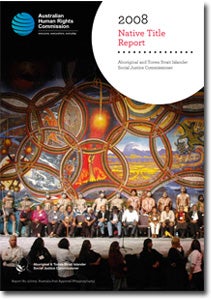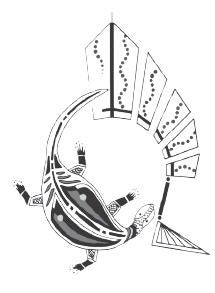Native Title Report 2008 - About the report and credits
Native Title Report 2008
About the report and credits
- About the Report
- Acknowledgements
- Cover Photography/Artwork
- Aboriginal and Torres Strait Islander
Social Justice Commissioner - About the Social Justice Commissioner’s logo
- Note – Use of the terms ‘Aboriginal and Torres Strait
- Ngallak Koort Boodja (Our Heart Land) Noongar representatives at the 2008 Native Title Conference, Proud and Strong…
About
2008 was a significant year for Aboriginal and Torres Strait Islander peoples with far reaching effects, not limited to native title. The election of the new federal government in 2007 brought a raft of policies aimed at improving the social and economic situation of Aboriginals and Torres Strait Islanders, many of which are inextricably linked to native title.
This year, in addition to examining the progress the government has made in achieving greater rights and equality for Indigenous peoples, and how the government can complement its symbolic Apology with practical, beneficial changes to the native title system, the focus for the Native Title Report 2008 addresses the topical issues of climate change and water. I also consider the protection of Indigenous knowledge in policies and processes developed in response to these issues.
In examining these issues, and more particularly the effect they have on Indigenous peoples in Australia, I make a number of recommendations aimed at heightening Indigenous participation and engagement in meeting these challenges.
As I have endeavoured to do in previous reports, the Native Title Report 2008 considers issues relevant to Aboriginal and Torres Strait Islander peoples now and for the future.
ISSN 1322-6017
Acknowledgements
The Aboriginal and Torres Strait Islander Social Justice Commissioner thanks the
Australian Human Rights Commission staff and consultants in producing this report
(Native Title Unit staff: Katie Kiss, Cecelia Burgman and Darren Dick; and others
who offered their time in preparing this report including: Sean Brennan, Virginia Falk,
Emily Gerrard, David Hanslow, Kevin Parnell, Steven Ross, Jessica Weir, Lauris de
Clifford, Jia Yi Lee, Siobhan Mackay, and Fiona Raphael).
This publication can be found in electronic format on the Australian Human Rights
Commission’s website at:
http://www.humanrights.gov.au/social_justice/nt_report/ntreport08/
For further information about the Australian Human Rights Commission, please visit: www.humanrights.gov.au/ or email paffairs@humanrights.gov.au.
You can also write to:
Native Title Unit
Australian Human Rights Commission
GPO Box 5218
Sydney NSW 2001
Design and layout
Jo Clark
Printing
Paragon Australasia Group
Cover Photography/Artwork
The cover photograph taken by Toni Wilkinson is courtesy of the Australian Institute
of Aboriginal and Torres Strait Islander Studies with permission from the South West
Aboriginal Land and Sea Council. The canvas in the photograph was used as the
backdrop for the 2008 Annual Native Title Conference held in Perth on Noongar
country. Six Noongar artists worked together to produce the master piece. They
were, Shane Pickett, Lance Chadd, Troy Bennell, Sharyn Egan, Alice Warrell and
Yvonne Kickett.
The material in this publication includes views and recommendations of individual
contributing authors, which do not necessarily reflect the views of the Australian
Human Rights Commission or indicate its commitment to a particular course of
action.
Please be aware that this publication may contain the names or images of Aboriginal and
Torres Strait Islander people who may now be deceased.
Aboriginal and Torres Strait Islander
Social Justice Commissioner
The position of the Aboriginal and Torres Strait Islander Social Justice Commissioner
was established within the Australian Human Rights Commission in 1993 to carry out the
following functions:
(1) Report annually on the enjoyment and exercise of human rights by
Aboriginal peoples and Torres Strait Islanders, and recommend where
necessary on the action that should be taken to ensure these rights are
observed.(2) Promote awareness and discussion of human rights in relation to
Aboriginal peoples and Torres Strait Islanders.(3) Undertake research and educational programs for the purposes of
promoting respect for, and enjoyment and exercise of, human rights by
Aboriginal peoples and Torres Strait Islanders.(4) Examine and report on enactments and proposed enactments to
ascertain whether or not they recognise and protect the human rights of
Aboriginal peoples and Torres Strait Islanders
The Commissioner is also required, under Section 209 or the Native
Title Act 1993 (Cth), to report annually on the operation of the Native
Title Act and its effect on the exercise and enjoyment of human rights by
Aboriginal peoples and Torres Strait Islanders.
About the Social Justice Commissioner’s logo
The right section of the design is a contemporary view of traditional Dari
or head-dress, a symbol of the Torres Strait Island people and culture. The head-dress suggests the visionary aspect of the Aboriginal and
Torres Strait Islander Social Justice Commissioner. The dots placed
in the Dari represent a brighter outlook for the future provided by the
Commissioner’s visions, black representing people, green representing
islands and blue representing the seas surrounding the islands. The
Goanna is a general symbol of the Aboriginal people.
The combination of these two symbols represents the coming together
of two distinct cultures through the Aboriginal and Torres Strait Islander
Commissioner and the support, strength and unity which it can provide
through the pursuit of social justice and human rights. It also epresents
an outlook for the future of Aboriginal and Torres Strait Islander social
justice, expressing the hope and expectation that one day we will be
treated with full respect and understanding.
© Leigh Harris
For information on the work of the Social Justice Commissioner
please visit the Commission website at:
http://humanrights.gov.au/social_justice/index.html
Note – Use of the terms ‘Aboriginal and Torres Strait
Islander peoples’ and ‘Indigenous peoples’
The Aboriginal and Torres Strait Islander Social Justice Commissioner
recognises the diversity of the cultures, languages, kinship structures
and ways of life of Aboriginal and Torres Strait Islander peoples. There
is not one cultural model that fits all Aboriginal and Torres Strait Islander
peoples.
Aboriginal and Torres Strait Islander peoples retain distinct cultural identities
whether they live in urban, regional or remote areas of Australia.
Throughout this report, Aborigines and Torres Strait Islanders are referred
to as ‘peoples’. This recognises that Aborigines and Torres Strait
Islanders have a collective, rather than purely individual, dimension to their
livelihoods. Throughout this report, Aboriginal and Torres Strait Islander
peoples are also referred to as ‘Indigenous peoples’.
The use of the term ‘Indigenous’ has evolved through international law. It
acknowledges a particular relationship of Aboriginal people to the territory
from which they originate. The United Nations High Commissioner for
Human Rights has explained the basis for recognising this relationship
as follows:
Indigenous or aboriginal peoples are so-called because they were living on
their lands before settlers came from elsewhere; they are the descendants
– according to one definition – of those who inhabited a country or a
geographical region at the time when people of different cultures or
ethnic origins arrived, the new arrivals later becoming dominant through
conquest, occupation, settlement or other means… (I)ndigenous peoples
have retained social, cultural, economic and political characteristics
which are clearly distinct from those of the other segments of the national
populations.Throughout human history, whenever dominant neighbouring peoples have
expanded their territories or settlers from far away have acquired new lands
by force, the cultures and livelihoods – even the existence – of indigenous
peoples have been endangered. The threats to indigenous peoples’ cultures
and lands, to their status and other legal rights as distinct groups and as
citizens, do not always take the same forms as in previous times. Although
some groups have been relatively successful, in most part of the world
indigenous peoples are actively seeking recognition of their identities and
ways of life.1
The Social Justice Commissioner acknowledges that there are differing
usages of the terms ‘Aboriginal and Torres Strait Islander’, ‘Aboriginal’ and
‘indigenous’ within government policies and documents. When referring to
a government document or policy, we have maintained the government’s
language to ensure consistency.
Ngallak Koort Boodja (Our Heart Land) Noongar
representatives at the 2008 Native Title Conference,
Proud and Strong…
The Ngallak Koort Boodja (Our Heart Land) Canvas
The project was developed over three years for the Noongar Focus of the Perth
International Arts Festival in 2006. The concept of a major artwork uniting all 14
Noongar clan groups including Wajuk, Amangu, Yued, Balladong, Binjareb, Wilmen,
Wardandi Geneang, Bibbulmen, Minang, Goreng, Wujari, Nyaki-Nyaki, and Kalaamaya
was guided by the Noongar Elders and representatives. These representatives were
elected to ensure that the project reflected in an art piece a symbol of the living culture
and strong identity of the Noongar Nation. Six artists worked together to produce
the master piece. The six Noongar artists were Shane Pickett, Lance Chadd, Troy
Bennell, Sharyn Egan, Alice Warrell and Yvonne Kickett.
The Canvas Explained
The half and full circles represent the 14 clans of the Noongar people, inner full
circles represent the six seasons.
- Eagles and crows – representing the summer season and the
heat of the summer when there are many carcasses. - Fire Tree – a symbol of all Noongar Country, as balga trees are
found all through Noongar Country. The arm coming out from
the land represents how Noongar people come from the land. - Perth – Kings Park.
- Full Moon – an important time of each month. The landscape
on this part of the canvas reflects the Carrolup style art. - Dolphins – Noongar people ‘sing up’ dolphins to herd fish up
to the shore so they can be caught. - Christmas Tree – Moodja – when people die, their spirits go
back to the tree. The tree is sacred and cannot be cut down.
It is also important for the shade it gives. - One river represents all rivers.
- One waterhole represents all waterholes.
- Yellow and orange goannas and turtles – for medicine.
- Stirling Ranges – place of the Golden Eagle.
- King George Sound – Albany.
[1] United Nations High Commissioner for Human Rights, Fact sheet No.9 (Rev.1), The Rights
of Indigenous Peoples (1997). At: http://www.unhchr.ch/html/menu6/2/fs9.htm (viewed
8 December 2008).
